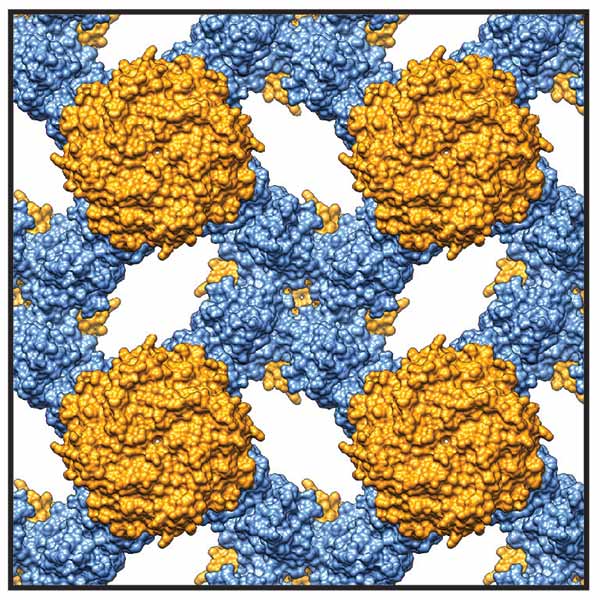
Chemists at UC San Diego have created an “adaptive protein crystal” with a counterintuitive and potentially useful property: When stretched in one direction, the material thickens in the perpendicular direction, rather than thinning as familiar materials do. And when squeezed in one dimension, it shrinks in the other rather than expanding, and gets denser in the process.
This strange behavior could prove useful for the sole of a running shoe that thickens for greater shock absorption as heel collides with pavement, for example, or to construct body armor that strengthens when a bullet strikes.
“It’s a property, called ‘auxetic,’ that has been not been previously demonstrated at the molecular level through design,” said Akif Tezcan, a professor of chemistry and biochemistry at UC San Diego who headed a team of researchers that detailed its invention in an advance online paper in this week’s Nature.
Tezcan’s group created a sheet-like crystal made of proteins connected in a regular, repeating pattern. They chose a protein called RhuA for its square shape and used it like tiles to make their material.
“We found a way to create strong, flexible, reversible bonds to connect the protein tiles at their corners,” Tezcan said. The flexibility allows the tiles to rotate to open spaces for a porous material or to close up in a kind of adaptable sieve.
Stretching or compressing the material in one directions causes the connected protein tiles to rotate in unison, resulting in a corresponding expansion or contraction in the opposite directions. The Poisson ratio, usually a positive measure for normal materials that stretch and shrink in opposition, describes this relationship. Tezcan’s group measured a Poisson ratio of -1 for their material, a value at the thermodynamic limit of what is possible.
The crystals form perfectly with almost no tiles missing or ajar, and the material is self-healing. Protein tiles easily pop into place, given the right chemical conditions.
“This is protein design using a highly chemistry-based approach,” Tezcan said, noting that the materials are made via a streamlined, minimalistic design strategy that requires few alterations to the protein building blocks.
“These materials are very easy to make, yet provide many new research directions both in terms of materials applications and understanding the fundamental principles of nanoscale self-assembly,” he added.
Other authors of the paper include Yuta Suzuki in Tezcan’s research group, David Restrepo and Pablo Zavattieri of Purdue University, Timothy Baker, a professor of chemistry and biochemistry and biology at UC San Diego, and Giovanni Cardone in Baker’s research group.
Learn more: ‘Adaptive Protein Crystal’ Could Form New Kind of Protective Material
The Latest on: Adaptive Protein Crystal
[google_news title=”” keyword=”Adaptive Protein Crystal” num_posts=”10″ blurb_length=”0″ show_thumb=”left”]
via Google News
The Latest on: Adaptive Protein Crystal
- Microgravity-grown crystals reveal new insights into protein structureson April 29, 2024 at 7:19 am
Biochemists have long been working around a blind spot when it comes to proteins. They know that hydrogen constitutes nearly half of the atoms in proteins, but how they contribute to protein function ...
- Should You Have Protein Before or After a Workout?on April 23, 2024 at 10:20 am
Research has found that consuming protein within the immediate and prolonged post-exercise recovery window can support the adaptive response seen in skeletal muscle. Exhaustive resistance exercise ...
- 5 Key Essentials Of Adaptive Leadershipon April 9, 2024 at 5:03 am
Marcus Aurelius wrote, "Obstacles do not block the path, they are the path." Adaptive leaders with a growth mindset do not just embrace this philosophy. They use it as fuel for their journey to ...
- 100 Grams of Protein: What It Actually Looks Like and How You Can Achieve It Dailyon April 6, 2024 at 9:00 am
Protein does more than build and repair muscle. It also regulates hormones, transports molecules, acts as an enzyme for chemical reactions and more. If you're not used to tracking or prioritizing ...
- Mechanistic approaches to the study of evolution: the functional synthesison October 12, 2023 at 8:47 pm
The functional synthesis of molecular evolution explicitly connects genotype with phenotype to allow mechanistic insights into the causes of adaptive ... of selection. Protein structures can ...
- JanSport Launches Highly Adaptive Bag And Backpack Range For Mobility Impairedon January 19, 2023 at 12:01 am
One of America’s leading bag and backpack brands JanSport dipped its toe into the adaptive fashion market this week when it launched its collection of highly accessible crossbody bags and backpacks.
- Can too much protein make you fat?on September 9, 2021 at 7:06 am
Protein is a miracle worker for muscle growth and development. But can too much protein make you fat? Here’s what the nutrition experts say. There’s a rumor going around the gym, and it goes ...
- Crystal Oscillators Explainedon December 8, 2018 at 7:01 am
We’ve read a lot about oscillators, but crystal oscillators seem to be a bit of a mystery. Hobby-level books tend to say, build a circuit like this and then mess with it until it oscillates.
- Getting Serious About Crystal Radioson April 7, 2016 at 12:20 am
A crystal radio is basically a high Q resonator tied to an antenna and an envelope detector. These days the envelope detector is a point contact diode such as a 1N34 Germanium diode. The resonant ...
- Protein Crystal Growthon March 4, 2016 at 11:22 am
Our organization first got its start supporting crystallographers and scientists performing NASA protein crystal growth (PCG) research in microgravity. Our currently available systems for supporting ...
via Bing News









